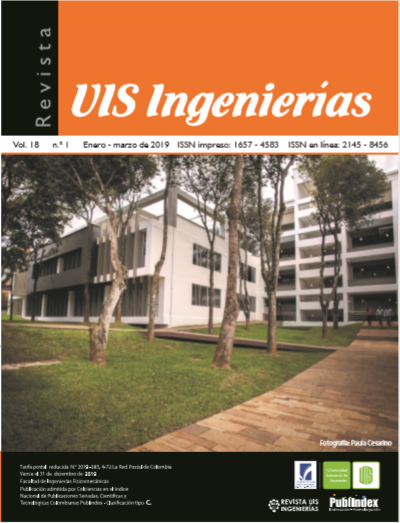Methodology to solve Mass-Spring-Dashpot (MSD) models through global optimization algorithms
Published 2019-01-01
Keywords
- Mass-spring-dashpot system,
- global optimization,
- firefly algorithm,
- natural frequency
How to Cite
Abstract
This article describes one way to solve the mathematical model of a system, which is made up of a Mass-Spring-Dashpot (MSD), by using the virtual firefly metaheuristic algorithm. By employing this strategy, the MSD problems are transformed into problems of minimization of the system’s maximum frequency for all its natural frequencies in such a way that the value found corresponds to the global minimum. The viability of this strategy was demonstrated by solving some typical examples of MSD systems. It was concluded that this algorithm is helpful, for it allows the user to dedicate more time to the analysis of the system itself rather than to the solution methods of the model. It was also significant as an unconventional way to resolve this kind of problems numerically.
Downloads
References
D. Gutierrez-Lemini, Engineering Viscoelasticity. Springer US, 2013.
H. F. Leung, A. P. Hu, “Modeling the Contact Interface of Ultrasonic Power Transfer System based on Mechanical and Electrical Equivalence,” IEEE Journal of Emerging and Selected Topics in Power Electronics, Vol. 6, no. 2, pp. 800-811, 2018. doi: 10.1109/JESTPE.2017.2720852
T. K. Maiti, D. Navarro, M. Miura-Mattausch, H. J. Mattausch, “Compact modeling approach for electro-mechanical system simulation,” 2017 IEEE 12th International Conference on ASIC (ASICON), Guiyang, 2017, pp. 981-984. doi: 10.1109/ASICON.2017.8252642
M. Sunar, A.Z. Sahin, B.S. Yilbas, “Entropy generation rate in a mechanical system subjected to a damped oscillation,” Int. J. Exergy, vol. 17, no. 4, pp. 401-411, 2015. doi: 10.1504/IJEX.2015.071557
M. Farid, N. Levy, O. Gendelman, “Vibration mitigation in partially liquid-filled vessel using passive energy absorbers,” Journal of Sound and Vibration, vol. 406, pp. 51-73, 2017. doi: 10.1016/j.jsv.2017.06.013
Y. Bian, Z. Gao, M. A. Fan, “Vibration Absorption Method for Alleviating Impact of the Flexible Robotic Arm,” Journal of Computational and Nonlinear Dynamics, vol. 12, no. 4, 2017. doi: 10.1115/1.4035409
Z. Li, Z. Yin, “Position tracking control of mass spring damper system with time-varying coefficients,” 2017 29th Chinese Control and Decision Conference (CCDC), Chongqing, 2017, pp. 4994-4998. doi: 10.1109/CCDC.2017.7979380
T. Aoki, Y. Yamashita, D. Tsubakino, “Vibration suppression for mass-spring-damper systems with a tuned mass damper using interconnection and damping assignment passivity‐based control,” Int. J. Robust. Nonlinear Control, vol. 26, no. 2, pp. 235-251, 2016. doi:10.1002/rnc.3307
M. Dureau, A. Alessandri, P. Bagnerini, S. Vincent, “Modeling and Identification of Amnioserosa Cell Mechanical Behavior by Using Mass-Spring Lattices,” IEEE/ACM Transactions on Computational Biology and Bioinformatics, vol. 14, no. 6, pp. 1476-1481, 2017. doi: 10.1109/TCBB.2016.2586063
P. E. Paredes, F. Ordoñez, W. Ju, J. A. Landay, “Fast & Furious: Detecting Stress with a Car Steering Wheel,” ACM Conference on Human Factors in Computing Systems (CHI 2018), Canada, 2018, pp. 10. doi: 10.1145/3173574.3174239
E. Sobhani Tehrani, K. Jalaleddini, R. E. Kearney, “Ankle joint intrinsic dynamics is more complex than a mass-spring-damper model,” IEEE Transactions on Neural Systems and Rehabilitation Engineering, vol. 25, no. 9, pp. 1568-1580, 2017. doi: 10.1109/TNSRE.2017.2679722
C. P. Vidal, L. I. G. Calandín, Modelado de sistemas dinámicos: aplicaciones. Editorial Club Universitario, 2012.
X. S. Yang, Engineering Optimization. USA: John Wiley & Sons, 2010.
X. S. Yang, Engineering optimization: an introduction with metaheuristic applications. USA: John Wiley & Sons, 2010.
G. Beni, J. Wang, “Swarm intelligence in cellular robotic systems,” Robots and Biological Systems: Towards a New Bionics?, Springer, 1993, pp. 703–712.
V. Y. Piqueras, J. R. M. Folgado, “Optimización heurística económica aplicada a las redes de transporte del tipo VRPTW,” tesis doctoral, Universidad Politécnica de Valencia, 2002.
C. Rodríguez-Ortiz, “Algoritmos heurísticos y metaheurísticos para el problema de localización de regeneradores,” trabajo de fin de grado, Universidad Rey Juan Carlos, 2010.
A. E. F. Clementi, P. Crescenzi, P. Penna, G. Rossi, P. Vocca, “On the complexity of computing minimum energy consumption broadcast subgraphs,” STACS '01 Proceedings of the 18th Annual Symposium on Theoretical Aspects of Computer Science, Dresden, pp. 121–131, 2001.
E. García, I. Amaya, R. Correa, “Algoritmos de optimización en la estimación de propiedades termodinámicas en tiempo real durante el tratamiento térmico de materiales con microondas,” Rev. UIS Ing., vol. 16, no. 2, pp. 129-140, 2017. doi: 10.18273/revuin.v16n2-2017012
H. G. Sánchez, J. Uscátegui, S. Gómez, “Metodología para la detección de fallas en una estructura entramada metálica empleando las técnicas de análisis modal y PSO,” Rev. UIS Ing., vol. 16, no. 2, pp. 43-50, 2017. doi: 10.18273/revuin.v16n2-2017004
P. Tymann, C. Reynolds, Schaum’s outline of principles of computer science. McGraw-Hill, Inc., 2008.
X. S. Yang, “Firefly Algorithms for Multimodal Optimization,” Stochastic Algorithms: Foundations and Applications, International Symposium on Stochastic Algorithms, Sapporo, vol. 5792, pp. 169-178, 2009.
M. A. Branham, J. W. Wenzel, “The origin of photic behavior and the evolution of sexual communication in fireflies (Coleoptera: Lampyridae),” Cladistics, vol. 19, no. 1, pp. 1–22, 2003. doi: 10.1016/S0748-3007(02)00131-7
I. Fister, X. S. Yang, J. Brest, “A comprehensive review of firefly algorithms,” Swarm Evol. Comput., vol. 13, pp. 34-46, 2013. doi: 10.1016/j.swevo.2013.06.001
K. Sörensen, “Metaheuristics - the metaphor exposed,” Int. Trans. Oper. Res., vol. 22, no. 1, pp. 3–18, 2015. doi: 10.1111/itor.12001
X. S. Yang, “Firefly algorithm, stochastic test functions and design optimisation,” Int. J. Bio-Inspired Comput., vol. 2, no. 2, p. 78, 2010. doi: 10.1504/IJBIC.2010.032124


